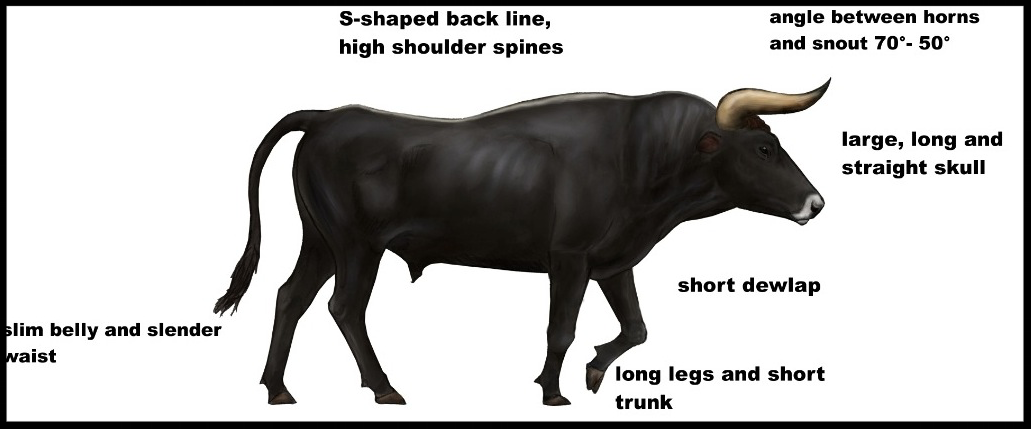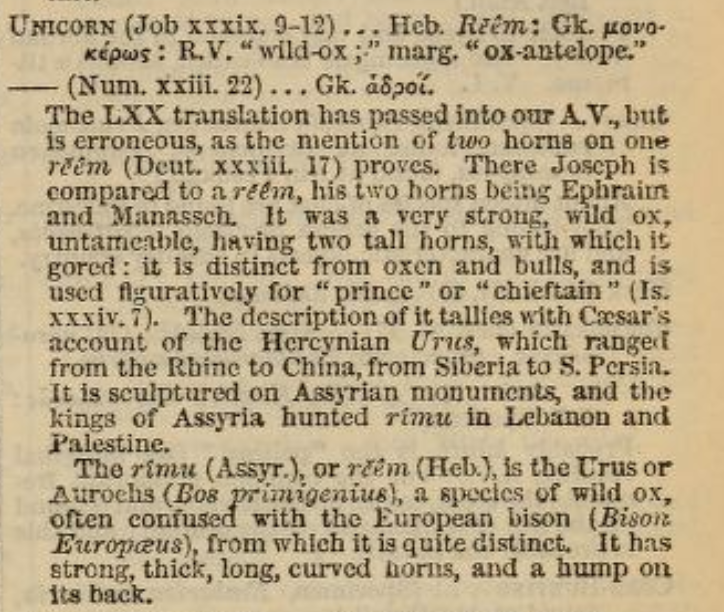The enormous Re'em
In tomorrow's daf yomi there is a rare and welcome break from the detailed discussions of the laws of sacrifices. It addresses the רימא, the re'em, an animal of enormous size. How, the Talmud wonders, did it survive the Great Flood of Noah? One possibility is that it fled to Israel, where, according to some, the waters of the flood did not reach. But there were other opinions that the Flood even reached Israel. In that case, how did the re'em survive? It could not have hid in Israel and it would have been too big to fit inside the Ark. Rabbi Yannai had an answer:
א"ר ינאי גוריות הכניסו בתיבה והאמר רבה בר בר חנה לדידי חזי לי אורזילא דרימא בת יומא והוי כהר תבור והר תבור כמה הויא ארבעין פרסי משכא דצואריה תלתא פרסי מרבעתא דרישא פרסא ופלגא רמא כבא וסכר ירדנא א"ר יוחנן ראשו הכניסו לתיבה והאמר מר מרבעתא דרישא פרסא ופלגא אלא ראש חוטמו הכניסו לתיבה
Rabbi Yannai says: They brought re'em cubs into the ark, and they survived the flood. [The Gemara asks:] But doesn’t Rabba bar bar Chana say: I have seen a day-old offspring of the reima, and it was as large as Mount Tabor. And how large is Mount Tabor? It is forty parasangs. And the length of the cub’s neck was three parasangs, and the place where its head rests, i.e., its neck, was a parasang and a half. When it cast its feces, it dammed up the Jordan river. [So even the cub would have been too large for the ark.] Rabbi Yoḥanan says: They brought only the head of the cub into the ark, while its body remained outside. The Gemara asks: But didn't Rabba bar bar Chana say that the size of the place where its head rests was a parasang and a half? [Consequently, even its head alone would not fit into the ark.] Rather, they brought the edge, of its nose into the ark, so that it might breathe.
Just what might be the identity of this mysterious, enormous animal? Let's take a look. But first some background.
The re'em in the Bible
The word ראם, re'em appears several times in the Hebrew Bible. Here, for example, is a verse from Deuteronomy (33:17) which describes the offspring of Joseph.
בְּכ֨וֹר שׁוֹר֜וֹ הָדָ֣ר ל֗וֹ וְקַרְנֵ֤י רְאֵם֙ קַרְנָ֔יו בָּהֶ֗ם עַמִּ֛ים יְנַגַּ֥ח יַחְדָּ֖ו אַפְסֵי־אָ֑רֶץ וְהֵם֙ רִבְב֣וֹת אֶפְרַ֔יִם וְהֵ֖ם אַלְפֵ֥י מְנַשֶּֽׁה׃
Like a firstling bull in his majesty, He has horns like the horns of the re'em; With them he gores the peoples, The ends of the earth one and all. These are the myriads of Ephraim, Those are the thousands of Manasseh.
The re'em is specifically identified by the great translator of the Bible Oneklos (~35-120 CE) as one of the species singled out in the Torah as being kosher:
זֹ֥את הַבְּהֵמָ֖ה אֲשֶׁ֣ר תֹּאכֵ֑לוּ שׁ֕וֹר שֵׂ֥ה כְשָׂבִ֖ים וְשֵׂ֥ה עִזִּֽים׃ אַיָּ֥ל וּצְבִ֖י וְיַחְמ֑וּר וְאַקּ֥וֹ וְדִישֹׁ֖ן וּתְא֥וֹ וָזָֽמֶר׃
These are the animals that you may eat; the deer, the gazelle, the roebuck, the wild goat, the dishon, the antelope, the mountain sheep.
Onkelos translates that word דִישֹׁ֖ן into Aramaic as רֵימָא - the re'em. And then there is this passage from the Book of Job (39:9-12):
הֲיֹ֣אבֶה רֵּ֣ים עָבְדֶ֑ךָ אִם־יָ֝לִ֗ין עַל־אֲבוּסֶֽךָ׃ הֲֽתִקְשָׁר־רֵ֭ים בְּתֶ֣לֶם עֲבֹת֑וֹ אִם־יְשַׂדֵּ֖ד עֲמָקִ֣ים אַחֲרֶֽיךָ׃
Most English versions of this passage translate the word re'em as "wild ox"and so read:
Would the wild ox agree to serve you? Would he spend the night at your crib? Can you hold the wild ox by ropes to the furrow? Would he plow up the valleys behind you?
But not the King James Bible. It goes in an entirely different direction:
Will the unicorn be willing to serve thee, or abide by thy crib? Canst thou bind the unicorn with his band in the furrow? or will he harrow the valleys after thee?
So according to the King James Bible, the re'em is a unicorn. Why on earth would the translators have chosen, of all creatures, the mythical unicorn as the re'em?
“The men who [produced the King James Bible], who pored over the Greek and Hebrew texts, comparing the accuracy and felicity of previous translations, arguing with each other over the finest details of chapter and verse, were many of them obscure at the time and are generally forgotten now, a gaggle of fifty or so black-gowned divines whose names are almost unknown but whose words continue to resonate with us.”
The re'em is a unicorn. Or maybe not.
Well, they didn't. They merely followed the Septuagint, the Greek translation of the Hebrew Bible from the third century BCE. And the Septuagint translated the Hebrew re'em as μονόκερως - monokeros, or "one horned". Which is why the King James Bible translated it as a unicorn, from the Latin uni meaning "single" and cornu meaning "horn". And since, according to the Talmud, the Septuagint was created at the command of Ptolemy II by seventy-two Jewish sages, you could claim that the King James translation was following a long Jewish tradition.
“King Ptolemy once gathered 72 Elders. He placed them in 72 chambers, each of them in a separate one, without revealing to them why they were summoned. He entered each one’s room and said: “Write for me the Torah of Moshe, your teacher”. God put it in the heart of each one to translate identically as all the others did.”
This translation made its way into later rabbinic commentary. For example, R. Dovid Kimche (1160-1235), in his dictionary of the Hebrew language called Sefer Hashorashim, wrote that the re'em has only one horn. And Abraham Yagel, (1553 – 1623), the Italian rabbi and exegete, mentioned a one-horned re'em that had been captured and brought to Portugal:
Book IV, ch. 45: 108a בית יער הלבנון
ובימנו הובא בארץ פורטוגאלי מן האי האינדי׳ ראם אחד במצודה צדו אותו ומראה צורתו הביאו אח׳כ עוברי אורחות ימים והוא גדול מהפיל ומזרין בקסקשיו בכל עורו וקרן חזות עב על חוטמו אשר בו לחם מלחמות עם הפיל ועם שאר החיות
And in our days a re'em was brought to Portugal from India having been ambushed and trapped, and afterwards sea travellers reported how it looked. It is larger than an elephant and its scales cover all its skin. It has a thick horn on its nose which it uses in fights with the elephant and with other creatures...
As Natan Slifkin points out, what Yagel what was actually describing was a rhinoceros: "It was given to King Manuel of Portugal by Alfonso de Albuquerque, governor of Portuguese India. This was the first rhinoceros to be brought to Europe since Roman times, and it caused quite a sensation." Quite so.
But before we conclude that the re'em was a rhinoceros, there are a couple of problems. First, although it was once found in the Land of Israel, the rhinoceros remains so far discovered only go back to the Mousterian era, which ended about 35,000 years ago. That's quite a few years before the biblical period. Thus it is very unlikely that there were rhinoceri in Israel in the biblical period. And second, the re'em in the Bible is described as having two horns. Two. "וְקַרְנֵ֤י רְאֵם֙ קַרְנָ֔יו" His horns are like the horns of the re'em" (Deut.33:17). So much for the rhinoceros or unicorn.
Artist's rendering of the aurochs. Is this the re'em mentioned in the Torah? From here.
A better candidate: The Aurochs
There is a better candidate for the mysterious re'em, but it is an animal neither you, nor I, nor anyone we know has ever seen. It is the aurochs, Bos primigenius, an enormous species of cattle that became extinct in 1627. The aurochs (pronounced oar-ox) weighed in somewhere around 1,500lb - or 700kg. That's certainly a big animal, though not as big as the Mount Tabor-sized beast described by Rabba bar bar Chana. It also has the added bonus of having two horns, just like the re'em described in the Torah. The suggestion that the re'em is the aurochs seems to have become popular with late nineteenth-century Christian scholars, as you can see here:
Sunday-School Teacher's Bible. Philadelphia, A.J Holman & Co. 1895. p115.
Matthew George Easton Illustrated Bible Dictionary. London, T. Nelson & Sons 1894. p678.
The Aurochs and the prehistoric cave paintings of Lasaux
Of all the animals that have intrigued human beings, perhaps none goes further back in time than the aurochs. Among the cave paintings of animals found in the Lasaux cave, are aurochs. And these paintings (there are nearly 6,000 of them) are from the Paleolithic period, 17,000 years ago. The largest of the aurochs depicted there is over 15 feet long. There are similar paintings of the aurochs in another cave system called La-Tete-Du-Lion in southern France, which has been dated to 26,000 BCE. We will, of course, never know with certainty whether the long-extinct aurochs was the re'em. But we have been fascinated with the aurochs for as long as we have walked the earth. What better candidate could there be for the mysterious creature that somehow survived Noah's flood.
Detail from the Lascaux cave drawing, about 17,000 years old.





